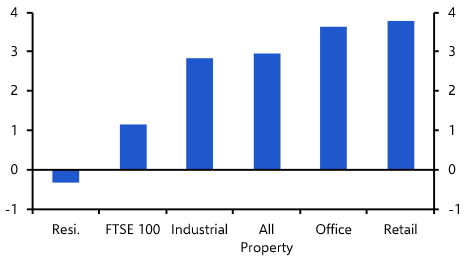Most of us have spent a large part of the past fortnight poring over central bank statements. You can read our take on last week’s Fed, BoJ and Bank of England meetings in the usual places on our website. And you can read our take on the ECB meeting earlier this month and our assessment of what else it could do here and here.
Lingering underneath the surface, however, a much bigger story is playing out – namely that central banks in several countries are now operating at the limits of what monetary policy can actually do. Admittedly, this is not the case in emerging economies. Central banks in Brazil and Indonesia cut interest rates last week, but have scope to lower them much further if required. The same is true of most other EMs.
Instead, this is a developed world problem. The Fed has sufficient tools to deal with a moderate economic slowdown but would struggle to respond adequately to a more significant downturn or recession. More immediately, central banks in the euro-zone and Japan are already at the limits of monetary support.
The reasons are familiar. Nominal interest rates are already below zero and, while we think that central banks have scope to cut them a bit further from here, their scope to do so is limited. That means that any further support would have to come through additional quantitative easing, but there is a growing body of academic work that suggests asset purchases are less effective at stimulating growth and inflation than conventional rate cuts. Meanwhile, government bond yields in Germany and Japan are negative across the curve, and yields in France are negative out to 10 years. Stepping back, with one-quarter of all government bonds now trading at negative yields, it’s difficult to see how monetary conditions could become much more supportive.
This has two implications.
The first is that, the closer interest rates are to the (nominal) lower bound, the stronger the case for fiscal support. It is certainly true that if the recent soft patch in developed market growth turns into something more serious, fiscal policy will have to do the heavy lifting in a subsequent policy response. But given the super-loose monetary policies that have been required to get the developed world back to full employment since the global financial crisis, there’s a case for a more fundamental rebalancing of policy settings towards greater fiscal support.
The second implication is that extremely low (or negative) yields have potentially big consequences for financial markets. There is growing evidence that low long-term interest rates and flat yield curves are weighing on banks’ profitability and affecting pension funds’ and insurers’ ability to meet their obligations. And while there is not much sign that low rates are fuelling asset price bubbles now, the risk that they lead to a misallocation of resources and/or inflate asset bubbles will increase the longer they stay at rock-bottom levels.
One final point to note is that deflation becomes a much bigger threat to financial markets when nominal interest rates are at or close to their lower bound. This is because if nominal rates can’t fall alongside prices then real rates necessarily have to rise. Our base case remains that inflation will remain low but positive over the next year or so. But if the world were to experience a deflationary shock with interest rates already so low, it would create a potentially toxic environment for asset markets. Poring over central bank statements is part and parcel of the job – but don’t lose sight of the bigger story that’s starting to play out in the background.
In case you missed it:
- We have launched a new Asset Allocation service. Our flagship Asset Allocation Outlook was published last week – if you’re interested in receiving it on a permanent basis email here.
- Our Commodities team takes stock of a tumultuous week in oil markets – and sketches out what might happen next.
- Our Senior India Economist, Shilan Shah, casts a sceptical eye over the government’s plan to double the size of India’s economy by 2035.



